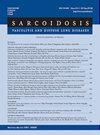Bronchoscopic Probe-Based Confocal Laser Endomicroscopy to Diagnose Diffuse Parenchymal Lung Diseases.
IF 1.8
4区 医学
Q4 RESPIRATORY SYSTEM
Sarcoidosis, Vasculitis, and Diffuse Lung Diseases
Pub Date : 2022-01-01
Epub Date: 2022-06-29
DOI:10.36141/svdld.v39i2.11280
引用次数: 3
Abstract
Background Diagnosis of diffuse parenchymal lung disease (DPLD) is based on clinical evaluation, radiological imaging and histology. However, additional techniques are warranted to improve diagnosis. Aims and objective Probe based confocal laser endomicroscopy (pCLE) allows real time in vivo visualisation of the alveolar compartment during bronchoscopy based on autofluorescence of elastic fibres. We used pCLE (Cellvizio®, Mauna Kea Technology. Inc, Paris, France) to characterise alveolar patterns in patients with different types of DPLD. Methods In this pilot study we included 42 therapy naive patients (13 female, age 72.6 +/- 2.3 years), who underwent bronchoscopy for workup of DPLD. pCLE images were obtained during rigid bronchoscopy in affected lung segments according to HR-CT scan, followed by cryobiopsies in the identical area. Diagnoses were made by a multidisciplinary panel. The description of pCLE patterns was based on the degree of distortion of the hexagonal alveolar pattern, the density of alveolar structures, the presence of consolidations or loaded alveolar macrophages (AM). The assessment was performed by 2 investigators blinded for the final diagnosis. Results The normal lung showed a typical alveolar loop pattern. In amiodarone lung disease loaded AM were predominant. COP showed characteristic focal consolidations. IPF was characterized by significant distortion and destruction, NSIP showed significant increase in density, and chronic HP presented with consolidations, mild distortion and density. Conclusion pCLE shows potential as an adjunctive bronchoscopic imaging technique in the differential diagnosis of DPLD. Structured and quantitative analysis of the images is required.


基于探针的支气管镜共聚焦激光内镜诊断弥漫性肺实质疾病。
背景:弥漫性肺实质疾病(DPLD)的诊断是基于临床评价、影像学和组织学。然而,需要额外的技术来提高诊断。目的和目的:基于探针的共聚焦激光内镜(pCLE)可以在支气管镜检查期间基于弹性纤维的自身荧光实时观察肺泡腔室。我们使用了pCLE (Cellvizio®,Mauna Kea Technology)。不同类型DPLD患者的肺泡模式特征。方法:在这项初步研究中,我们纳入了42名未接受治疗的患者(13名女性,年龄72.6±2.3岁),他们接受了支气管镜检查以检查DPLD。在硬支气管镜下根据HR-CT扫描在受影响的肺段获得pCLE图像,然后在同一区域进行冷冻活检。诊断是由一个多学科小组做出的。pCLE模式的描述是基于六边形肺泡模式的扭曲程度,肺泡结构的密度,实变或负载肺泡巨噬细胞(AM)的存在。评估由2名盲法研究者进行,以获得最终诊断。结果:正常肺呈典型肺泡环型。在胺碘酮肺部疾病中,负荷AM占主导地位。COP表现出特征性的局灶实变。IPF表现为明显的扭曲和破坏,NSIP表现为明显的密度增加,慢性HP表现为实变,轻度扭曲和密度。结论:pCLE可作为支气管镜鉴别诊断DPLD的辅助技术。需要对图像进行结构化和定量分析。
本文章由计算机程序翻译,如有差异,请以英文原文为准。
求助全文
约1分钟内获得全文
求助全文
来源期刊
CiteScore
2.20
自引率
6.20%
发文量
34
期刊介绍:
Sarcoidosis Vasculitis and Diffuse Lung Disease is a quarterly journal founded in 1984 by G. Rizzato. Now directed by R. Baughman (Cincinnati), P. Rottoli (Siena) and S. Tomassetti (Forlì), is the oldest and most prestigious Italian journal in such field.

 求助内容:
求助内容: 应助结果提醒方式:
应助结果提醒方式:


